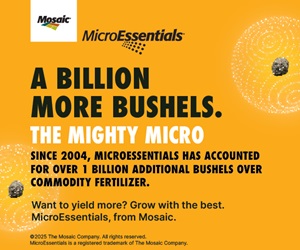Cropside: Tires and soil compaction
AGRONOMIC INFORMATION FROM ONTARIO'S CROP SPECIALISTS

THERE ARE SEVERAL main theories on how to avoid or manage soil compaction, these are:
1) confine traffic to lanes within the field to provide traffic-free zones for crop production,
2) avoid wheel traffic on wet soils which are susceptible to compaction,
3) use equipment with lower axle weights,
4) increase the size of the “foot print” by employing radial tires, larger tires, more tires, or tracks
5) reduce tire inflation pressures and therefore soil contact pressures.
figure 1. Tire footprints and compaction profiles for a fully loaded 8,000 gallon Husky manure tanker (~ 21,000 lbs/tire) fitted with Alliance Agri-Transport 35.5LR32 radial tires at 18 PSI (left) and Firestone ANS Tractor 35.5L-32 bias ply tires at 32 PSI (right). (Courtesy Sam Bradshaw, Ontario Pork and 2013 North American Manure Expo)

There has been considerable effort across the industry to do at least two of the above — that is, to increase tire size and reduce inflation pressures. This generally results in lower ground contact pressures and therefore less soil rutting and compaction, as shown in Figure 1 where a loaded manure tanker with radial tires (left) at 18 PSI resulted in a larger foot print and a rut which was 10cm shallower than bias ply tires (right) at 32 PSI.
Certainly the use of larger foot print tires, with inflation pressure adjusted correctly for axle load has been an important tool in reducing compaction risks. This is demonstrated in Figure 2 where the inflation pressure of a radial tire on a fully loaded manure tanker is reduced to meet minimum load bearing requirements from road speed (40 PSI at 25 MPH) to field spreading speed (18 PSI at 5 MPH). Being able to adjust tire inflation pressures at the field edge to maximize tire floatation for the slower in-field operating speeds has been common in Europe for years but is just starting to get traction in Ontario.
figure 2. Tire footprints for an Alliance Agri-Transport 35.5LR32 radial tire fitted on a fully loaded 8,000 gal Husky manure tanker (~ 21,000 lbs/tire) at tire inflation pressures of 40, 28 and 18 PSI. (Equipment courtesy of Husky Farm Equipment and the Alliance Tire Group)



Soil compaction can be a yield limiting, expensive problem. Efforts should be made to avoid causing it in the first place. Proper tires with correctly adjusted inflation pressures can significantly reduce surface compaction and are at least part of the solution for subsoil compaction threats as axle loads continue to climb.
Ben Rosser, University of Guelph, collaborated on this report. •

















